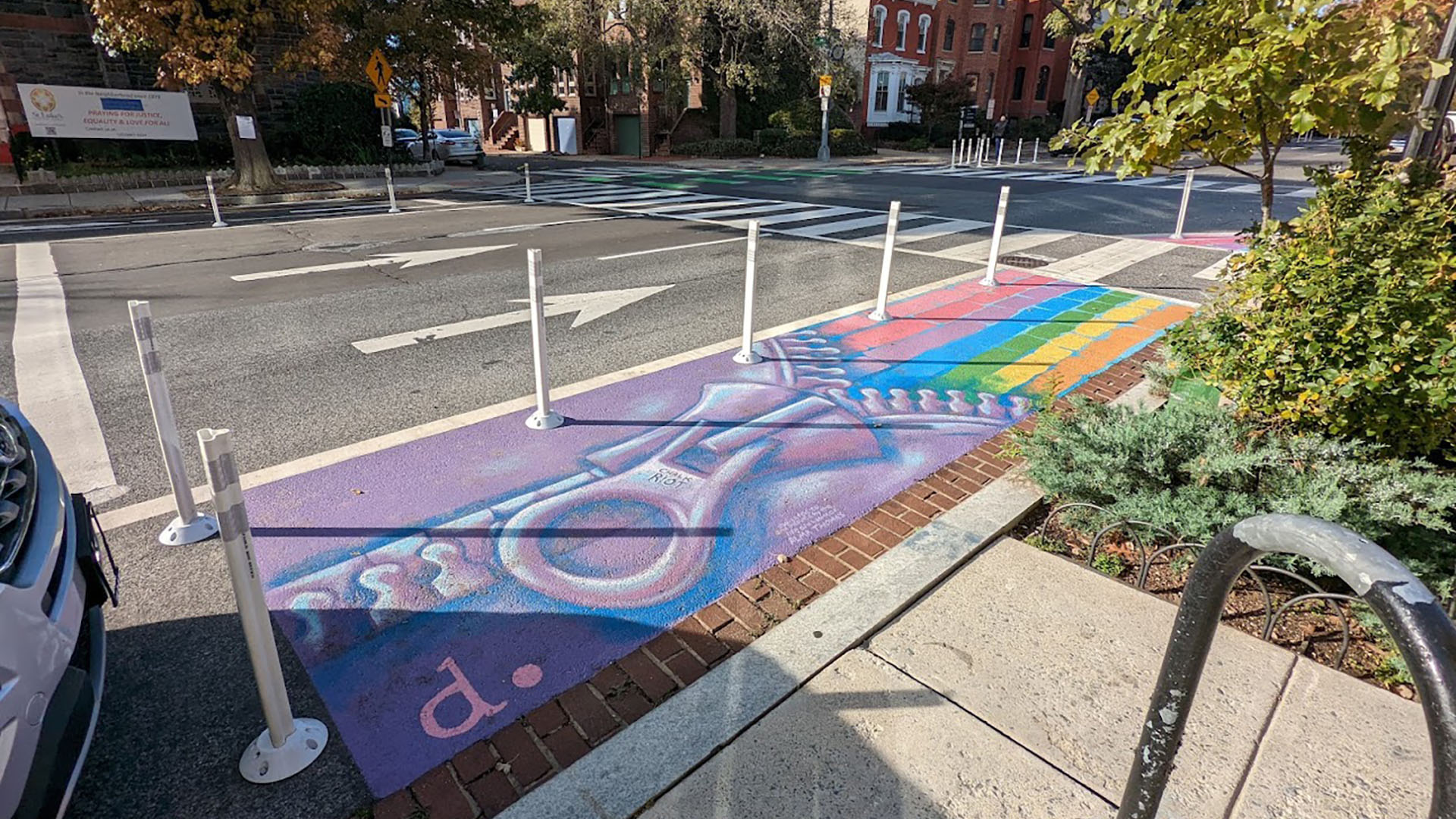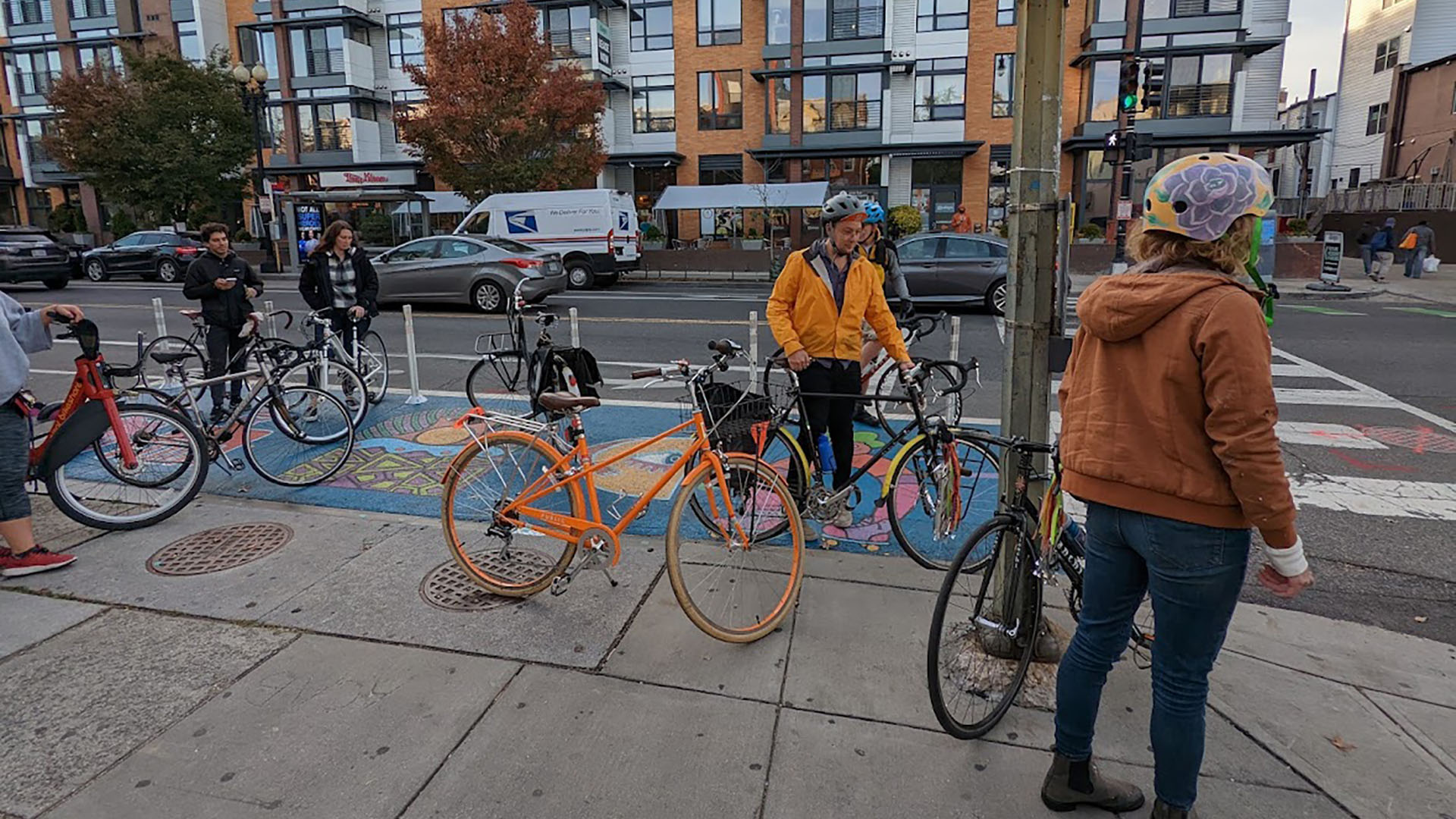March 31, 2022
Strengthening DC: Quick Builds Come to Life
(Project Update)
The District Department of Transportation (DDOT) put forth big dreams in 2021: creating quick build improvements at 40 intersections in busy neighborhoods that were facing persistent safety challenges. And it has followed through. We helped DDOT achieve its dream by designing 40 quick builds, all of which have been implemented, with rippling impacts on safety, multimodal mobility, and community connectivity. Now, these transformative test projects are getting turned into permanent solutions.
One such project is a roundabout at the precarious intersection of three streets right by a middle and high school and a senior living community. This roundabout puts Vision Zero thinking into action at a site where change is most needed. Before, a confusing array of irregular turns and stoplights sprawled; now, a roundabout, curb extensions, and high-visibility crosswalks fill the space. From its journey as a painted circle in the road to the landscaped roundabout that will be completed next year, this project has simplified traffic flow, slowed speeds, and made life safer for the many people using these streets every day.
What’s more, this infrastructure is rooted in art. A poem by artist Mazaré calling for traffic safety reform at the intersection of 14th Street and Meridian Ave helped inspire the whole collection of the 40 projects. Revisit our 2022 article on DC’s quick build initiative to learn the story behind other artistic streets—one that still rings true three years later. You can find out more about where they’re at today on the project website and see progress happen in real time. These improvements are embodying Mazaré’s message: wherever you’re going, “let us help you get there.”
…

A curb extension by Chalk Riot, celebrating the work and life of D.C.-based artist and educator Alma Thomas.
These quick build projects use temporary materials, like paint and flex posts, to make discrete and tactical changes to existing infrastructure, often with an outsized consequence: across the nation, quick build projects have proven essential in helping cities adapt to the COVID-19 pandemic by creating outdoor dining spaces and reallocating road space.
In the case of D.C.’s neighborhoods, however, quick builds reflect a different, burgeoning effort within transportation thinking to make streets safer and more comfortable for their most vulnerable users. Most importantly, these interventions allowed the District to uphold a long-held promise to its citizens to reduce the number of annual traffic-related fatalities and serious injuries.
D.C.’s Journey to Zero Fatalities
In 2015, Washington, D.C., began pursuing strategies to reach zero traffic-related fatalities and serious injuries by 2024, joining the effort known as “Vision Zero.” While the initiative’s first move was to raise traffic fines for a variety of car-centric offenses (like speeding, rolling turns, or obstructing the path of a bicyclist with a car door), these changes alone did not make a big difference in the number of serious injury and fatal crashes-in fact, the number of traffic fatalities increased between 2015 and 2018. Spurred by the desire to bring about swifter, more effective change, the District Department of Transportation (DDOT) began pursuing quick build safety projects across the District.
In an effort to address the community’s concerns, DDOT commissioned Kittelson to conduct the first safety and mobility study, now known as the Near Northwest III Safety and Mobility Study, across a swath of the District’s midtown neighborhoods. Whereas a “feasibility” study is broad in scope, requiring planners to consider transit problems of various scales and develop short-, medium-, and long-term solutions to these problems, a “safety and mobility” study narrows the focus to purely short-term solutions with rapid delivery. DDOT plans to conduct more Safety and Mobility Studies in communities with transportation equity needs and areas along high injury corridors, as identified in moveDC.
Findings & Recommendations of the Near Northwest III Study
The Near Northwest III study employed a battery of metrics, including crash history, field observations, and community feedback, to identify specific intersections of concern in the region of study. These different metrics provided Kittelson and DDOT with different insights: for instance, while the crash data was instrumental in identifying intersections where visibility was hampered, the community feedback collected from DDOT’s office hours and virtual public workshops uncovered areas where walkers had trouble accessing public amenities like parks, as well as missing crosswalks and bicycle infrastructure. The project team identified 40 specific intersections that posed safety concerns and formulated tailored recommendations to improve the safety of each intersection.
In every case, the recommendations served to clarify the traffic flow at problem intersections or formalize existing traffic rules that may not have been followed by people who drive. Some of the simple installations recommended by the study included:
- Increasing striping and signage to remind drivers that they cannot park near intersections, improving visibility of people walking and biking.
- Applying bicycle conflict paintings at crossings to increase driver awareness of bicyclist movements.
- Using “left-turn hardening” with flex posts at left-turn lanes to slow turning vehicles and prevent corner-cutting by people driving.
- Working with local artists to realize public art in quick build installations, both drawing attention to the changes and highlighting the unique character of each neighborhood.
- Using curb extensions to tee-up intersections, shortening the length of the crosswalk, and improving driver visibility of people walking.
The Near Northwest III safety and mobility study concluded in 2021, with 10 of the study’s recommendations already implemented. Since then, the District has constructed six additional intersection installations; the remaining 24 are expected to be complete by 2024. These quick build interventions don’t limit vehicles or discourage citizens from using their cars; rather, by doing things like increasing the visibility of pedestrians at intersections and adding bicycle crossing enhancements, they focus on empowering people who walk and bike.
By doing things like increasing the visibility of pedestrians at intersections and adding bicycle crossing enhancements, they focus on empowering people who walk and bike.
The Power of Quick Build
Turning to quick build projects to address urgent safety concerns has offered real advantages for all involved in the Near Northwest III safety and mobility project.
- The fast project installations provided immediate relief to vulnerable users while demonstrating to community leaders that their concerns had merit and were worthy of action.
- Quick build projects let the communities try out adjustments to their roads before committing to them permanently.
- For planners, quick build projects simplify processes: because many quick build measures tweak how traffic in an area operates instead of fundamentally changing it, planners don’t have to conduct extensive traffic studies before they can start making changes that will increase the public’s safety.
- Quick build solutions offer flexibility to local governance, who can choose to convert these projects into permanent fixtures as funds become available and based on feedback from the public. (D.C. City Council is currently discussing a bill that would make it even easier to renovate quick build implementations into lasting traffic infrastructure.)
These recommendations, one by one, are rethinking how streets can serve and protect individuals beyond those who use cars. How did our project team and the commissioned artists celebrate? With a bike tour through the safer, more vibrant neighborhoods of Near Northwest III, of course!

Kittleson consultants and ChalkRiot pause their bicycle tour to admire a curb extension by Rosy Sunshine Galvan.
At Kittelson, we’re always eager to further refine our understanding of how civic infrastructure can better serve communities and work with local leaders to find creative and resourceful solutions to longstanding problems. If you want to learn more about the Near Northwest III Safety and Mobility Study, visit the District’s website for the project here. Feel free to reach out to us to discuss any of these ideas further!
